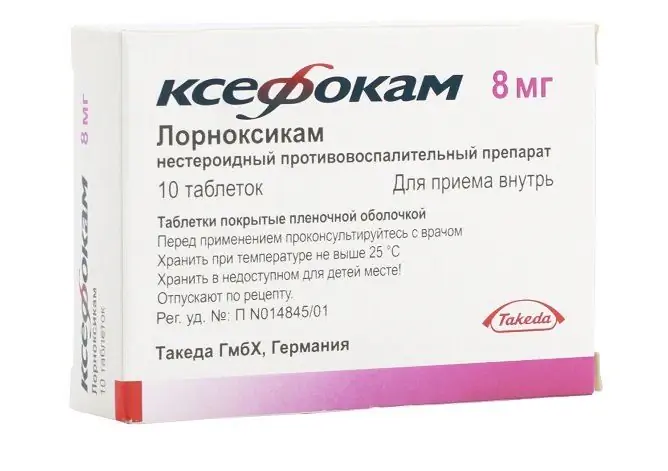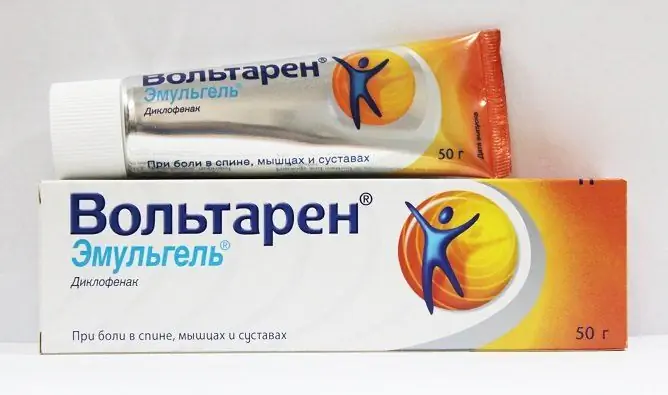- Author Rachel Wainwright [email protected].
- Public 2024-01-15 19:51.
- Last modified 2025-11-02 20:14.
Medication for cervical osteochondrosis
The content of the article:
- General provisions of drug treatment
-
Means for drug therapy of osteochondrosis
- Release forms
- NSAIDs
- Analgesics
- Chondroprotectors
- Muscle relaxants
- Topical preparations
- Blockade preparations
- Other drug groups
- Video
Drug treatment of osteochondrosis of the cervical spine is one of the main methods of its treatment during periods of exacerbation.
Treatment options are directly dependent on the stage of the disease: conservative therapy is the main treatment option in the first two stages (chondrosis and instability of the articular surfaces), in the next (intervertebral hernia and fibrosis), surgical methods of treatment can be used.
A specific scheme is prescribed by the attending physician after laboratory and instrumental diagnostics.
General provisions of drug treatment
- A relatively long course of admission (7-14-30 days). Depends on the form of the disease.
- Continuous monitoring (once a month) of the treatment results.
- Selection of an individual dose (may differ from that prescribed in the protocols).
- More than one course of treatment is often required (2-3).
- It is not recommended to take a complex of 3 or more drugs at the same time due to uncontrolled cross reactions.
- In the absence of positive dynamics, a replacement of drugs or a solution to the issue of surgical intervention is indicated.
- Medical treatment of osteochondrosis of the cervical spine is included in the treatment regimen along with other methods such as physiotherapy, exercise therapy, massage.
Means for drug therapy of osteochondrosis
|
Group of drugs |
Group characteristics |
| Non-steroidal anti-inflammatory drugs (NSAIDs) | They have three types of action: analgesic, anti-inflammatory and antipyretic. |
| Analgesics | They suppress the transmission of nerve impulses and, thus, muffle or completely stop the pain syndrome. |
| Muscle relaxants | Relieve muscle spasm caused by reflex irritation of nerve endings. |
| Chondroprotectors | It is used to protect the articular surfaces from further destruction. |
| Vascular agents (vasodilators) | Used to dilate spasmodic compressed vessels. They also slightly activate collateral vessels. |
| Local therapy | Any ointments and gels for local irritating, analgesic or regenerating action are allowed. |
| Novocaine and lidocaine blockades | A technique aimed at injecting the drug directly into the affected area (completely relieves pain). The most effective and at the same time the most traumatic type of conservative therapy. |
Release forms
- medicines for oral use (tablets, powder, capsules);
- injections for intramuscular and intravenous administration;
- preparations for topical use;
- drugs for injection directly into the affected disc or into the perineural space.
NSAIDs
This group is basic when choosing drugs for osteochondrosis, since it includes drugs that provide a pronounced decrease in inflammation in the zone of the degenerative process (compression of the neurovascular bundle is somewhat reduced).
Classification according to chemical structure:
- derivatives of salicylic acid - Aspirin;
- derivatives of pyrozolidines - Phenylbutazone;
- derivatives of indoleacetic acid - Indomethacin;
- phenylacetic acid derivatives - Diclofenac;
- oxicams - Piroxicam, Tenoxicam.
Depending on the effect on certain groups of receptors, they are divided into COX 1 and COX 2.
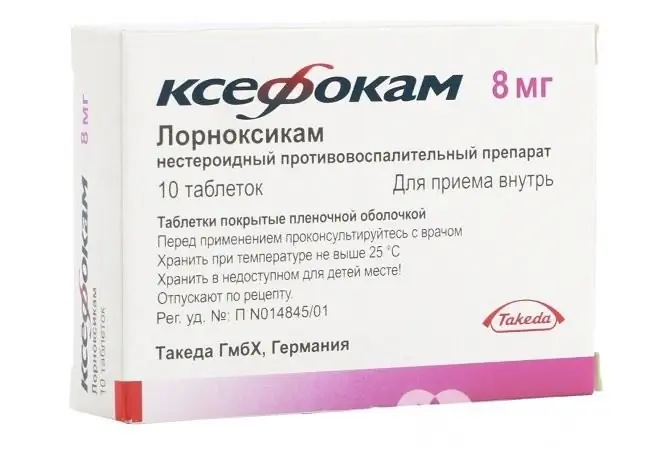
Ksefokam is a drug from the NSAID group
Drug names of choice:
- Ksefokam - belongs to the group of oxicams. It has a good analgesic effect, moreover, it promotes the production of endogenous analgesics in the body, which significantly enhance its effect. Available in tablets of 4 and 8 mg, respectively, and taken once a day or two. Also available in the form of a solution for injections (a single dose for numbing the neck and head is 8 mg). Constant monitoring of the liver and kidneys is required. The average course is 7 days.
- Meloxicam (Movalis) belongs to the selective blockers of COX 2. Relieves pain and suppresses inflammation. Patients are initially prescribed a course of intramuscular injections (15 mg once a day for 6 days), and then switch to tablets (drink one 15 mg tablet once for 20 days). Has a minimum of side effects.
- Diclofenac. Helps to treat severe inflammatory reactions in the affected area. Has the best relief of symptoms with intramuscular injections (75 mg 1-2 times a day, course up to 10 days).
The treatment protocols list a wide range of different drugs, and the choice of a particular one will depend on the characteristics of the clinic, the doctor's personal preferences and the patient's response to treatment (choosing the right drug can take time).
Analgesics
Since pain is the main symptom of the disease, prescribing analgesics is paramount. Non-steroidal anti-inflammatory drugs provide an analgesic effect, but with intractable pain syndrome, it becomes necessary to send the patient to a hospital for treatment with strong narcotic analgesics.
Groups of painkillers:
- stimulate receptors - Fentanyl, Promedol;
- partially stimulate and partially block receptors - Buprenorphine, Pentazocine, Tramadol;
- block the work of receptors - Nalmefen, Naltrexone.
The group's representative is Tramadol. Does not cause marked depression of the respiratory and vascular centers, and also does not cause drug dependence. The classic dosage is 100-200 mg. The release forms are different - ampoules, suppositories, tablets.
Central analgesics can also include tricyclic antidepressants (the mechanism of action is similar to Tramadol). The most effective dose of Amitriptyline is 25-75 mg per day. The course of treatment lasts several months.
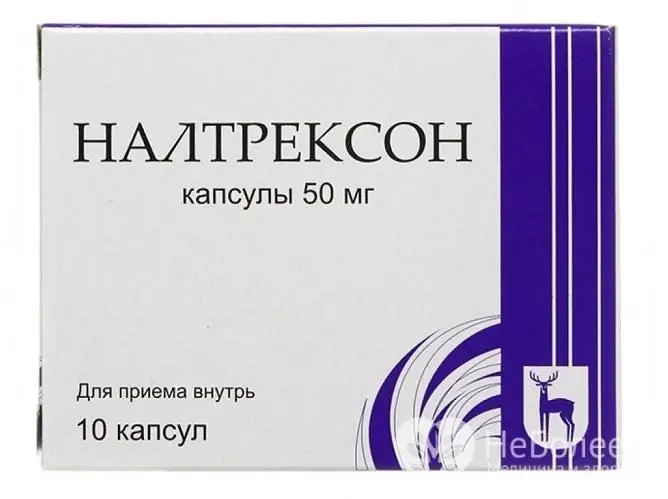
Naltrexone is an analgesic (pain relieving) drug
Chondroprotectors
An auxiliary group of substances that is associated with the maintenance of the normal structure of cartilage tissue. The clinical effect in severe anatomical deformities of the intervertebral disc is doubtful.
Examples of drugs:
- Chondroitin sulfate - consists of natural structural elements (cartilage derivatives). Has few side effects. Requires a long course of treatment.
- Alflutop affects the functioning of cartilage cells (chondrocytes). Provides the synthesis of collagen, hyaluronic acid and restores the damaged elements of the joint.
The positive effect occurs in 50-55% of cases.
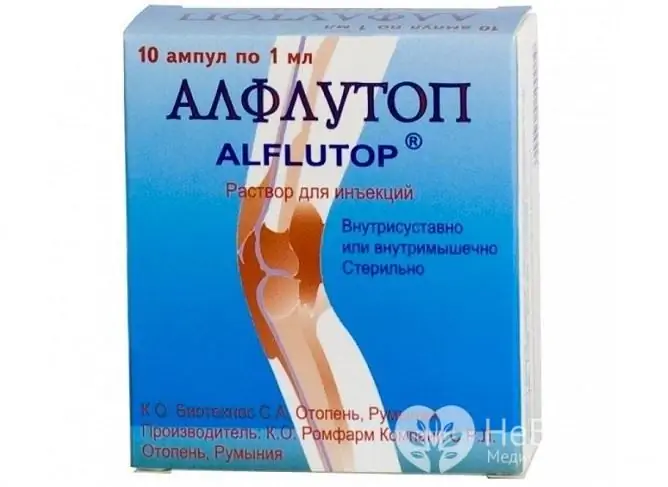
Alflutop - a drug from the group of chondroprotectors
Muscle relaxants
Included in the treatment regimen due to the need to eliminate severe muscle spasm.
The drugs are presented in two groups:
- central action: Metacarbamol, Oxazole, Thiazine;
- peripheral action: Suxamethonium, Pancuronium.
They are also divided depending on the rate of membrane depolarization (duration of action):
- depolarizing - less than 10 minutes;
- non-depolarizing - more than 20 minutes.
Examples of drugs:
- Sirdalud. Effective for muscular-tonic syndromes of any genesis. Pain relief is achieved through local action on muscle tissue and through antinociceptive action (signals at the level of the spinal cord). It is prescribed in a dose of 3-12 mg / day, the optimal dose is 6-8 mg / day. Positive dynamics is visible only on day 3. Protects the stomach lining from additional damage. Requires careful prescription together with antihypertensive drugs (enhances their effect).
- Mydocalm (tolperizona hydrochloride) has both analgesic and relaxing effect. It is used initially as an intramuscular injection (100 mg intramuscularly 2 times a day for 5 days), and then in tablet form (150 mg 3 times a day).

Sirdalud is a drug belonging to the group of muscle relaxants
Topical preparations
Local therapy is an auxiliary element in the treatment of osteochondrosis, since it has no pronounced effect on the deep layers of tissues. It is more often used to form a new dominant (they form another pain point with the help of irritating ointments, which would interrupt the pain caused by the main lesion).
Ointments, gels, creams have a weak analgesic, warming and irritating effect.
Example drugs:
- Nise gel. It contains nimesulide (non-steroidal anti-inflammatory drug). Has a pronounced analgesic effect.
- Fastum gel. It has a pronounced irritating effect and penetrates quite deeply into the tissues.

Fastum gel - local irritant
Blockade preparations
Blockades provide the most pronounced analgesic effect; they are used for therapeutic or diagnostic purposes for severe pain syndromes.
Various blockade options are used: conduction block, subcutaneous block, ganglion block. A combination of several drugs from different groups is more often used (analgesics, muscle relaxants, glucocorticoids, vasodilators).
An example of classic blockades:
- Novocainic. For infiltration anesthesia, 0.125%, 0.25% and 0.5% novocaine solution is used (maximum dose 60 ml). For conduction anesthesia use 1 and 2% solutions (maximum dose up to 20 - 40 ml) For nerve plexus blockade - 10-20 ml of 1% solution or 5-10 ml of 2% solution.
- Lidocaine. Lidocaine is used in the form of solutions of 0.25, 0.5, 1 and 2%. Has a slightly later onset than lidocaine (5 minutes). Action time - up to 3 hours.
- Mercainic. The longest of the above (action up to 6 hours). The onset of the analgesic effect occurs in 10-15 minutes.
It often takes several courses to achieve the desired action.

Lidocaine, a local anesthetic used to perform blockages
Other drug groups
There are a number of drugs that are used only in the treatment of osteochondrosis of the cervical spine, since they are associated with the effect on the vascular component of the disease (vertebral artery syndrome occurs only with cervical osteochondrosis):
- Actovegin. It is used to prevent ischemic processes in the brain. Partially provides restoration of normal metabolism in tissues. It is produced in the form of a solution for injection (5 ml intravenously or intramuscularly).
- Valsacor. Refers to drugs with a pronounced antihypertensive effect. It is used to stabilize blood pressure (prevents sudden pressure surges in the narrowed vertebral artery).
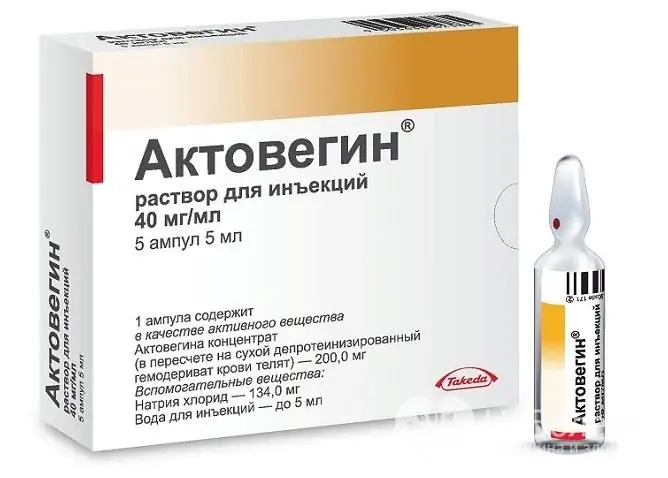
Actovegin improves brain metabolism
Video
We offer for viewing a video on the topic of the article.

Anna Kozlova Medical journalist About the author
Education: Rostov State Medical University, specialty "General Medicine".
Found a mistake in the text? Select it and press Ctrl + Enter.

